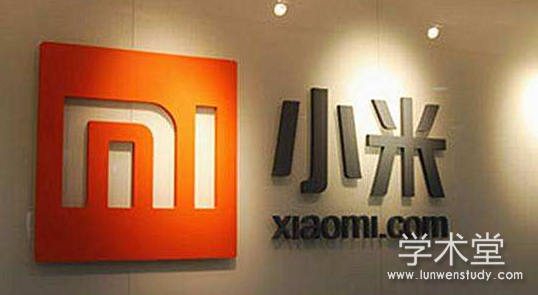摘 要
随着互联网普及程度的大大提高以及信息通讯技术的突飞猛进,顺应着时代的潮流诞生了一系列互联网企业。而小米公司作为成立仅有九年的一家互联网公司却凭借着其独有的商业模式在众多互联网企业中脱颖而出,快速成长为了在国内处于领先地位的互联网企业。其不仅凭借着 460 亿美元的估值成为了国内排名第三的独角兽企业,而且还在 2018 年成功在香港证券交易所正式挂牌上市。小米公司的商业模式是企业以较低的利润率销售智能硬件之后,通过搭载在上面的 MIUI 系统为顾客提供互联网服务。可以看出,小米公司本质上是一家互联网公司,只不过其获客渠道区别于传统的互联网企业。
小米公司对外销售智能硬件的业务本质上就是其互联网业务的获客渠道,这也是大众对小米公司的认知更倾向于其是一家硬件公司的原因。虽然这种商业模式能够通过智能硬件的使用促进小米公司互联网业务用户的粘性,但是由于其既涉及到智能硬件行业又涉及到互联网行业,这使得小米公司在实现既定战略目标的工作中受到的各种影响更多,其所面临的战略风险更为复杂。在这种背景下,小米公司急需一种既简便易行又行之有效的战略风险管理工具。而目前,国内外对战略风险的研究更多的倾向于全面、精准的对其定义、类型以及成因进行阐述,很少有学者尝试开发一种既简单易懂,使企业管理者能够迅速熟练掌握又能和实务工作紧密结合的战略风险管理理论。而学术界对平衡计分卡的认识更多的是将其视为绩效评价工具,虽然也有学者将其和风险管理相结合,但并未对其在战略风险管理领域的应用进行深入研究。
本文根据上述背景利用平衡计分卡这种战略管理工具对小米公司战略风险管理的问题进行研究。在理论部分,首先简要介绍诸如研究背景、国内外研究现状、论文的基本框架等内容,以其作为文章的起点,统领全文,然后借鉴了前人的研究内容,为战略风险进行了定义并且介绍了贯穿于全文的平衡计分卡理论和风险管理理论,最后明确了将平衡计分卡引入战略风险管理工作中的优越性。在实践部分,遵循传统的风险管理理论,以小米公司的战略风险识别、小米公司的战略风险评估、小米公司的战略风险应对三方面为基本思路开展工作。在小米公司的战略风险识别过程中,首先介绍小米公司的主要业务以及其既定的战略目标,然后对其所处的战略环境从宏观、中观、微观三个角度进行分析,最后对战略目标和战略环境矛盾的方面,以平衡计分卡的四个维度为类别进行归纳整理。在小米公司的战略风险评估过程中,从风险发生的可能性以及风险发生后对战略目标的负面影响力两个角度进行评估,对于前者以简单的模糊综合评价法对风险发生的可能性进行打分,对于后者用平衡计分卡的四个维度作为纽带建立层次结构,用层次分析法为战略风险进行赋权,以权重衡量各战略风险的负面影响力。在小米公司的战略风险应对过程中,首先针对平衡计分卡四个维度的性质以及小米公司的组织框架,将风险应对的工作进行了分工,然后对于分析出的较为重点的战略风险提出了应对措施。
在对小米公司的战略风险运用平衡计分卡的思路进行研究后发现,小米公司的总体战略风险的评级十分接近于风险较低的等级,其诸如收入结构风险、网络负面信息风险等战略风险需要重点关注,针对重点关注的战略风险提出了诸如增强互联网业务变现能力、正面回应网络负面信息等具体措施。可以说,本文不仅为企业的战略风险管理找到了新的研究思路,从实务的角度诠释了将平衡计分卡引入企业战略风险管理工作的可行性及优越性,而且还结合小米公司的具体情况为基于平衡计分卡的战略风险管理梳理出了一整套流程,既能加强小米公司战略风险的管理水平,又能为其他类似企业的战略风险管理工作提供借鉴。
关键词:风险管理 平衡计分卡 战略风险 层次分析法

Abstract
With the great increase in the popularity of the Internet and the rapid advancement ofinformation and communication technologies, a series of Internet companies have been bornin line with the trend of the times As an Internet company founded only nine years ago,Xiaomi has stood out among many Internet companies with its unique business model and hasgrown rapidly to become a leading Internet company in China Not only has it become thethird-ranked unicorn company in China with a valuation of $46 billion, but it has also beenofficially listed on the Hong Kong Stock Exchange in 2018 Xiaomi's business model is thatafter the company sells intelligent hardware at a lower profit margin, it provides Internetservices to customers through the MIUI system It can be seen that Xiaomi Company isessentially an Internet company, except that its customer channel is different from traditionalInternet companies The business of Xiaomi's external sales of intelligent hardware isessentially the channel of its Internet business This is why the public's perception of Xiaomiis more inclined to be a hardware company This business model can promote the stickiness ofXiaomi's Internet business users through the use of intelligent hardware However, because itinvolves both the intelligent hardware industry and the Internet industry, it has made Xiaomimore impactful in achieving its strategic goals, and its strategic risks are more complicated
Therefore, Xiaomi Company urgently needs a strategic risk management tool that is bothsimple and effective At present, the research on strategic risk at home and abroad tends toexplain its definition, type and cause of comprehensive and precise Few scholars are basedon the development of a strategic risk management theory that is simple and easy tounderstand, enabling business managers to quickly master and integrate with practical work
The academic community's understanding of the Balanced Scorecard is more of aperformance evaluation tool Although some scholars have combined it with risk management,they have not conducted in-depth research on its application in the field of strategic riskmanagement
Based on the above background, this paper uses the strategic management tool of Balanced Scorecard to study the issue of Xiaomi's strategic risk management In thetheoretical part, firstly introduce the contents such as the research background, the researchstatus at home and abroad, the basic framework of the paper, etc, and use it as the startingpoint of the article to lead the full text Then draw on the research content of the predecessors,define the strategic risks and introduce the balanced scorecard theory and risk managementtheory throughout the full text Finally, the superiority of introducing the Balanced Scorecardinto strategic risk management is clearly defined In the practice part, following the traditionalrisk management theory, the basic ideas of Xiaomi's strategic risk identification, Xiaomi'sstrategic risk assessment and Xiaomi's strategic risk response are carried out In Xiaomi'sstrategic risk identification process, we first introduce Xiaomi's main business and itsestablished strategic goals Then, the strategic environment in which it is located is analyzedfrom the perspectives of macro, meso and micro Finally, the four aspects of the balancedscorecard are classified into categories for the contradiction between the strategic objectivesand the strategic environment In Xiaomi's strategic risk assessment process, it evaluates fromthe perspective of the possibility of risk occurrence and the negative impact on the strategicobjectives after the risk occurs For the former, the risk of occurrence is scored by a simplefuzzy comprehensive evaluation method For the latter, the hierarchy is first established usingthe four dimensions of the balanced scorecard as a link Then use AHP to determine theweight of strategic risks, and use weight to measure the negative impact of each strategic risk
In the strategic risk response process of Xiaomi Company, the work of risk response wasfirstly divided according to the nature of the four dimensions of the Balanced Scorecard andthe organizational framework of Xiaomi Company Then, countermeasures were put forwardfor the analysis of the more important strategic risks
After researching the idea of using the balanced scorecard for Xiaomi's strategic risk, itwas found that Xiaomi's overall strategic risk rating is very close to the lower risk level, andthere are some strategic risks that need to be focused on, such as the risk of income structureand the risk of brand and reputation damaged Thus Xiaomi company should finish somespecific measures such as enhancing the ability of the Internet to liquidate and properly handling the negative information of the internet It can be said that this paper not only findsnew research ideas for strategic risk management of enterprises, but also explains thefeasibility and superiority of introducing balanced scorecard into enterprise strategic riskmanagement from the perspective of practice, and also combines the specific situation ofXiaomi Company A set of processes for strategic risk management based on balancedscorecards can not only strengthen the management level of Xiaomi's strategic risk, but alsoprovide reference for strategic risk management of other similar enterprises
Key Words:Risk management;Balanced scorecard;Strategic risk;Analytic hierarchyprocess
目 录
一、绪 论
(一)研究背景与研究意义
1.研究背景
随着科学技术越来越发达,新的行业也不断出现,在如今网络应用已经走进了千家万户,而其他通信技术也在不断进步,顺应着时代的潮流诞生了一系列的互联网企业。
北京小米科技有限责任公司(以下简称小米公司)就是其中的佼佼者。小米公司诞生于2010 年,是一家互联网公司,但其却以包括智能手机在内的各种智能硬件为发家的起点。
从成立到现在,只用了九年的时间就已经成长为了国内互联网企业的巨头。根据国家权威机构科技部在 2018 年公布的《中国独角兽企业发展报告》中的数据来看,小米公司以 460 亿美元的估值位列国内独角兽企业排名中的第三位。而在 2018 年 7 月 9 日,小米公司又向前迈出了一大步,在香港证券交易所正式挂牌上市。
小米公司之所以能够成长的如此迅速与其制定的商业模式关系密切,小米公司的商业模式是公司以线上线下相结合的销售渠道向用户出售各种搭载着由小米公司设计的MIUI 操作系统的智能手机或其他智能硬件商品,在拥有的大量智能硬件使用者的基础上,为使用者提供丰富的互联网业务。可以看出,小米公司最终的落脚点为互联网业务,其最终目的是通过提供的互联网服务变现来获取收益,而现如今无论是从公司的财务数据还是从大众认知来看,对小米公司的认识都更倾向于小米公司是一家以手机为主,以其他智能硬件为辅的智能硬件企业。这种理想与现实之间的差距为公司所制定的战略的实现蒙上了不确定性的面纱。
战略管理的研究开端于二十世纪五六十年代的西方国家,距今只有五十多年的研究历史,而国内学者对战略管理研究仅有二十余年的研究历史。战略风险管理作为战略管理的一个分支,被人们所重视并研究的时间更加短暂,国外学术界到上世纪七八十年代才有学者首次针对战略风险进行定义,而国内学术界对战略风险进行研究更是到二十一世纪初才开始。然而无论是战略风险管理乃至于更高一层的战略管理在提出之后都瞬间变成了学者们研究的热点。到目前为止,国内外学术界对战略风险的具体含义还没有一致的观点,对战略风险管理也更多注重的是理论方面的研究,还没有一个能被广大学者所共同承认的既简便易行又行之有效的研究战略风险管理的理论。
【由于本篇文章为硕士论文,如需全文请点击底部下载全文链接】
2. 研究意义
(二)国内外研究现状
1. 国外研究现状
2. 国内研究现状
3. 国内外研究述评
(三)研究内容及方法
1. 研究内容
2. 研究方法
(四)创新点
1. 将平衡计分卡运用到战略风险管理全流程中
2. 将基于平衡计分卡的战略风险管理运用到了微观企业
二、概念界定与相关理论
(一)概念界定
(二)相关理论
1. 平衡计分卡理论
2. 风险管理理论
(三)平衡计分卡引入战略风险管理的优越性
1. 平衡计分卡有利于实现战略风险管理目标
2. 平衡计分卡有利于战略风险应对措施的落实
3. 平衡计分卡有利于全面分析战略风险驱动因素
三、小米公司战略风险管理概况
(一)小米公司基本信息
1. 公司简介
2. 小米公司的战略目标
(二)小米公司战略风险的驱动因素
1. 宏观战略环境与战略目标的矛盾
2. 中观战略环境与战略目标的矛盾
3. 微观战略环境与战略目标的矛盾
(三)小米公司战略风险管理的现状及不足
1. 风险识别未突出战略目标
2. 战略风险评估结果无体现
3. 战略风险防范分工不明确
四、基于平衡计分卡的小米公司战略风险识别
(一)财务维度的战略风险
1. 存货和其他资产发生减值风险
2. 现金流风险
3. 汇率风险
4. 收入结构风险
(二)顾客维度的战略风险
1. 行业发展放缓风险
2. 市场竞争风险
3. 大客户流失风险
4. 网络负面信息风险
(三)内部流程维度的战略风险
1. 知识产权风险
2. 原材料供应链风险
3. 产品创新能力不足风险
4. 业务外包风险
(四)学习与成长维度的战略风险
1. 管理能力不满足扩张速度风险
2. 管理团队和企业文化变化风险
3. 无法持续招聘和留住人才风险
五、基于平衡计分卡的小米公司战略风险评估
(一)战略风险评估的整体思路
(二)战略风险评估的具体过程
1. 小米公司战略风险的影响能力评估
2. 小米公司战略风险可能性评估
3. 小米公司战略风险综合评估
(三)小米公司战略风险结果分析
1. 小米公司目标层战略风险分析
2. 小米公司准则层战略风险分析
3. 小米公司方案层战略风险分析
六、基于平衡计分卡的小米公司战略风险应对
(一)落实各维度战略风险应对责任
1. 小米公司内部组织结构
2. 各维度战略风险应对部门分工
(二)制定重点战略风险应对措施
1. 增强互联网业务变现能力
2. 提高新产品或技术的研发能力
3. 继续开拓国外市场
4. 提高外包公司选择标准
5. 正面回应网络负面信息
七、结论与展望
(一)结论
(二)不足与展望
参考文献





